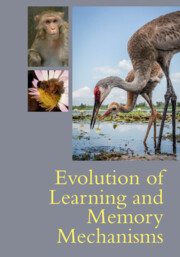Book contents
- Evolution of Learning and Memory Mechanisms
- Evolution of Learning and Memory Mechanisms
- Copyright page
- Contents
- Figures
- Tables
- Contributors
- Preface
- Introduction
- Part I Evolution of Learning Processes
- Part II Evolution of Memory Processes
- 16 The Evolution of Memory as an Immediate Perceptual Identification Mechanism
- 17 Episodic Memory in Animals
- 18 Evolutionary Origins of Complex Cognition
- 19 Evolution of Memory Systems in Animals
- 20 What Laboratory and Field Approaches Bring to Bear for Understanding the Evolution of Ursid Cognition
- 21 Distinguishing Mechanisms of Behavioral Inhibition and Self-control
- 22 Metacognitive Monitoring and Control in Monkeys
- 23 Adaptive Memory
- 24 Remembering Cheaters
- 25 Development of Memory Circuits under Epigenetic Regulation
- 26 Constraints on Learning and Memory
- Index
- References
20 - What Laboratory and Field Approaches Bring to Bear for Understanding the Evolution of Ursid Cognition
from Part II - Evolution of Memory Processes
Published online by Cambridge University Press: 26 May 2022
- Evolution of Learning and Memory Mechanisms
- Evolution of Learning and Memory Mechanisms
- Copyright page
- Contents
- Figures
- Tables
- Contributors
- Preface
- Introduction
- Part I Evolution of Learning Processes
- Part II Evolution of Memory Processes
- 16 The Evolution of Memory as an Immediate Perceptual Identification Mechanism
- 17 Episodic Memory in Animals
- 18 Evolutionary Origins of Complex Cognition
- 19 Evolution of Memory Systems in Animals
- 20 What Laboratory and Field Approaches Bring to Bear for Understanding the Evolution of Ursid Cognition
- 21 Distinguishing Mechanisms of Behavioral Inhibition and Self-control
- 22 Metacognitive Monitoring and Control in Monkeys
- 23 Adaptive Memory
- 24 Remembering Cheaters
- 25 Development of Memory Circuits under Epigenetic Regulation
- 26 Constraints on Learning and Memory
- Index
- References
Summary
Integrating an appreciation of natural behavior into laboratory studies, and laboratory techniques into field studies allows researchers to examine and control proximate factors while identifying adaptive problems faced by particular species. This focus reveals both important similarities and differences across phylogenetic lineages. Carnivores other than canids have been relatively neglected in the study of cognition. An examination of members of the ursid family reveals the important role of foraging ecology in shaping learning and memory in both wild and captive settings. Whereas top-down approaches tend to be anthropocentric, a bottom-up approach focused on the unique capacities and traits of individual species bears the most fruit in terms of understanding the selective pressures responsible for the emergence and maintenance of those traits.
- Type
- Chapter
- Information
- Evolution of Learning and Memory Mechanisms , pp. 359 - 374Publisher: Cambridge University PressPrint publication year: 2022
References
- 1
- Cited by



